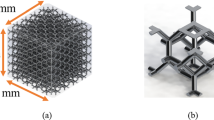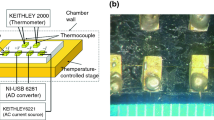Abstract
In this study, a method which would improve reliability of coated vertical type micro-probe under Joule heating is described. The method is to decouple the mechanical and electrical characteristics of a probe. That is, the method is to coat a metal with good electrical characteristics on a core metal with a good mechanical characteristics by electroplating. For various configurations of cross-sectional area of probe, FE analysis are performed, and a fabricated vertical micro-probe is tested to improve the accuracy of FE analysis. By increasing the coating thickness of a metal (gold, Au) with good electrical characteristics by electroplating while keeping a total cross-sectional area of a probe constant, the maximum temperature of probe continues to decrease as the cross-sectional area of core metal (nickel, Ni) with the good mechanical characteristics is reduced. A simple formula to predict the maximum temperature of probe depending on the coating thickness based on the results of FE analysis is proposed. The formula describe that the maximum temperature of the probe by Joule heating is a function of the ratio of the conductivity of the coating metal to the core metal and the ratio of the cross-sectional area of the coating metal to the total cross-sectional area of the probe.











Similar content being viewed by others
Abbreviations
- \(\dot{Q}_{Joule}\) :
-
Joule heat generation rate
- \(\dot{Q}_{cond}\) :
-
Conductive heat transfer rate
- \(\dot{Q}_{conv}\) :
-
Convective heat transfer rate
- \(I\) :
-
Electrical current
- \(R\) :
-
Total electrical resistance of the probe
- \(R_{coating}\) :
-
Resistance of coating
- \(R_{core}\) :
-
Resistance of core
- \(\rho\) :
-
Electrical resistivity
- \(\rho_{coating}\) :
-
Electrical resistivity of coating
- \(\rho_{core}\) :
-
Electrical resistivity of core
- \(A\) :
-
Total cross-sectional area
- \(A_{coating}\) :
-
Cross-sectional area of coating
- \(A_{core}\) :
-
Cross-sectional area of core
- \(l_{c}\) :
-
Characteristic length of the probe
- \(r\) :
-
Area fraction of coating
- \(k\) :
-
Thermal conductivity
- \(k_{coating}\) :
-
Thermal conductivity of coating
- \(k_{core}\) :
-
Thermal conductivity of core
- \(T_{0}\) :
-
Temperature of the upper and lower ends of probe
- \(T_{max}\) :
-
Maximum temperature of probe
- \(\uplambda\) :
-
Ratio of thermal conductivity of core to that of coating
- \(C^{*}\) :
-
Calibration parameter for maximum temperature estimation equation
References
Mann, W. R., Taber, F. L., Seitzer, P. W., & Broz, J. J. (2005). The leading edge of production wafer probe test technology. In Proceedings of the international test conference, October 26–28, Charlotte, New York, USA.
Marinissen, E. J. (2012). Challenges and emerging solutions in testing TSV-based 2 1/2D- and 3D-stacked ICs. In Proceedings of the conference on design, automation and test in Europe, Dresden, Germany.
Lee, K. Y., Huang, J. T., Chao, P. S., Lin, J. M., & Hsu, H. J. (2014). An integrated electroless nickel plating process for fabrication of CMOS-MEMS probe chip. Microelectronic Engineering, 113, 147–151.
Wang, F., Cheng, R., & Li, X. (2009). MEMS vertical probe cards with ultra-densely arrayed metal probes for wafer-level IC testing. Journal of Microelectromechanical System, 18(4), 933–941.
Chiu, J. T., & Chang, D. Y. (2009). A new probe design combining finite element method and optimization used for vertical probe card in wafer probing. Precision Engineering, 33, 395–401.
Kwon, H. J., Lee, J. W., Shin, B. H., Jeon, S. J., Han, C. S., & Im, C. M. (2014). Geometry design of vertical probe needle using mechanical testing and finite element analysis. International Journal of Precision Engineering and Manufacturing, 15(11), 2235–2342.
Zafer, B., & Tunaboylu, B. (2016). A predictive model for wafer probe burn phenomenon. Applied Thermal Engineering, 98, 610–616.
Ye, H., Basaran, C., & Hopkins, D. C. (2003). Thermomigration in Pb–Sn solder joints under Joule heating during electric current stressing. Applied Physics Letters, 82(7), 1045–1047.
Kvashnin, D. G., Ghorbani-Asl, M., Shtansky, D. V., Golberg, D., Krasheninnikov, A. V., & Sorokin, P. B. (2016). Mechanical properties and current-carrying capacity of Al reinforced with graphene/BN nanoribbons: A computational study. Nanoscale, 8, 20080–20089.
Lai, Y.-S., & Kao, C.-L. (2006). Electrothermal coupling analysis of current crowding and Joule heating in flip-chip packages. Microelectronic Reliability, 46(8), 1357–1368.
Jiang, M., Fu, G., Fogsgaard, M. B., Bahman, A. S., Yang, Y., & Iannuzzo, F. (2019). Wear-out evolution analysis of multiple-bond-wires power modules based on thermo-electro-mechanical FEM simulation. Microelectronics Reliability, 100–101, 113472. https://doi.org/10.1016/j.microrel.2019.113472.
Tanab, Z.-Q., & Chen, Y.-C. (2019). Size-dependent electro-thermo-mechanical analysis of multilayer cantilever microactuators by Joule heating using the modified couple stress theory. Composites Part B: Engineering, 161(15), 183–189.
Jung, H. W., Kim, S. J., Kim, Y. J., Kim, J. Y., Lee, J. Y., & Park, J. H. (2017). Finite element analysis of vertical micro-probe considering Joule-heating effect. International Journal of Fatigue, 101(1), 96–105.
Dassault Systems. (2013). Abaqus version 6.13 manual. Velizy-Villacoublay: The Company.
Ho, C. Y., Ackerman, H. W., Wu, K. Y., Havill, T. N., Bogaard, R. H., Matula, R. A., et al. (1983). Electrical resistivity of ten selected binary alloy systems. Journal of Physical and Chemical Reference Data, 12(2), 26–239.
Callister, W. D., Jr., & Rethwisch, D. G. (2013). Fundamentals of material science and engineering (4th ed.). Singapore: Wiley.
Incropera, F. P., Dewitt, D. P., Bergman, T. L., & Lavine, A. S. (2013). Principles of heat and mass transfer (7th ed.). Singapore: Wiley.
Acknowledgements
This research was supported by Kyungsung University Research Grants in 2018
Author information
Authors and Affiliations
Corresponding author
Additional information
Publisher's Note
Springer Nature remains neutral with regard to jurisdictional claims in published maps and institutional affiliations.
Rights and permissions
About this article
Cite this article
Jung, HW., Kim, YJ. & Park, JH. Study on Estimation Method for Maximum Temperature of Multi-layered Micro-probe by Joule-Heating. Int. J. Precis. Eng. Manuf. 21, 1955–1964 (2020). https://doi.org/10.1007/s12541-020-00392-y
Received:
Revised:
Accepted:
Published:
Issue Date:
DOI: https://doi.org/10.1007/s12541-020-00392-y




